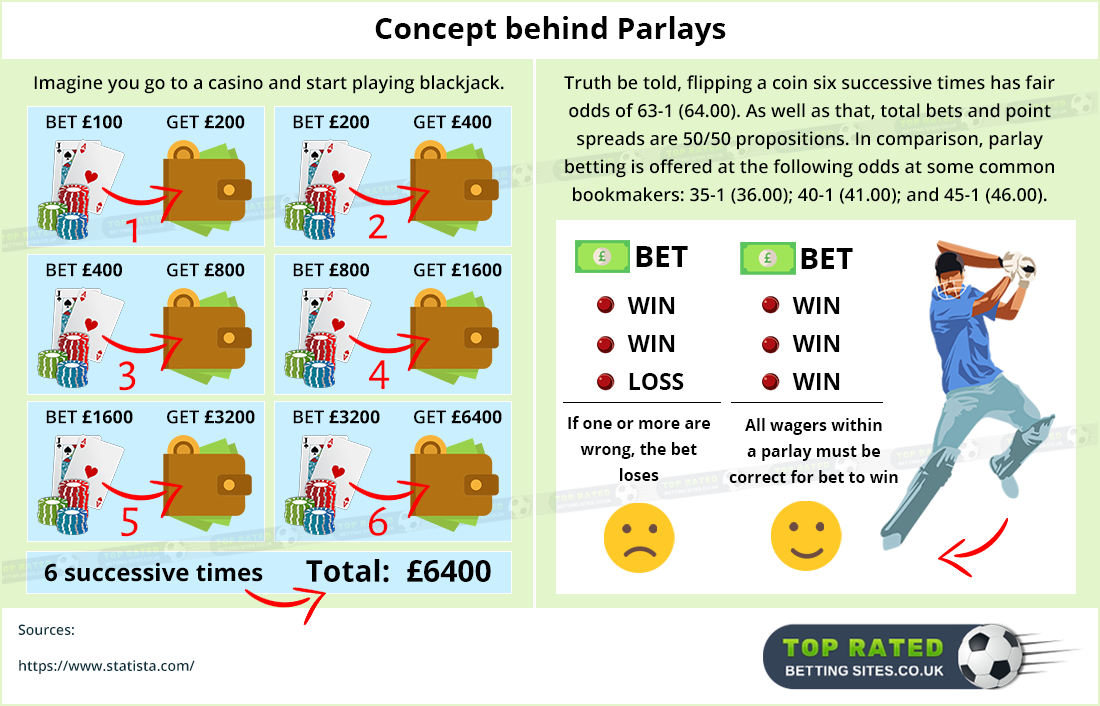How Do Parlays Work
- How Do Parlay Work On Bovada
- How To Parlay
- How Do Parlays Work In Vegas Sportsbooks
- How Do Teaser Parlays Work
- How Do Parlays Work On Bet365
Parlay betting is considered to be exotic or “specialty wagers” wherein you bet on a series of games. A parlay is a minimum of 2 games and it can go up to 12 games – depending on the online basketball sportbook and the actual sport and category being bet on. Usually all of the games have to end the way you predicted for you to win the whole parlay. Thus, if you are betting on a 4-team parlay, all 4 bets have to win. If even one of the bets is unsuccessful/lost, then the whole parlay is a loss. Why bet on them then? Well, the bigger the parlays the bigger the payout, although is also comes with a lot more risk associated with it.
Calculating Basketball Parlay Bets
* Please see illustration below to help understand parlay bets, text explanation follows.
How to Play FanDuel Sportsbook Same Game Parlay To make a Same Game Parlay bet on FanDuel. A parlay is a single sports wager that involves two or more bets combined into one. This can include point spreads, moneylines, totals, futures, or even prop bets, as long as the bets are on different games. The allure of these bets has always been a larger payout than choosing a single team to win.
How Do Parlay Work On Bovada
You can parlay money lines, over/under bets, as well as spreads. We will use a money line example to demonstrate how parlays are calculated. Let us say you want to bet on two NBA games: San Antonio Spurs versus Memphis Grizzlies, and Dallas Mavericks versus Los Angeles Lakers. The odds are listed as:

Game 1
How To Parlay
- San Antonio Spurs (+130)
- Memphis Grizzlies (-150)
Game 2
- Dallas Mavericks (+230)
- Los Angeles Lakers (-280)
Let us say you want to bet on the underdogs, San Antonio and Dallas. You are parlaying the bet, betting $100 total. If the Spurs win, then that $100 will get you a total of $230 ($130 won plus $100 bet). Then, that $230 goes into the Mavericks bet at (+230) line, getting you a total of $759 ($529 won plus $230 bet) if they win. Thus, a single bet of $100 gets you total winnings equal to $759. For that to happen in regular money lines there would have to be a huge underdog with (+659) money line, and that will actually win, which is rare to find.
You can boost your returns even more by betting on even more team-parlays, where the winnings will be accrued in the same manner as above.
Multiple Parlays
Sometimes sportsbooks can allow bettors to construct multiple parlay combos with different money lines, over/under bets, proposition bets and even with different sports. For example, you can bet on which team is going to win the NBA championship, which team is going to win in a baseball match and what will be the spread in a hockey match. However, there is a condition that the bets must not be connected with each other. For instance, if one bet is for LA Lakers beating Chicago Bulls, then you cannot also bet in a parlay if Lakers are going to become champions. To say the least, these multiple parlay bets can get very complicated. The more complicated they are, the more risky they are, and the less of a chance for you to win.
Basketball Parlay Betting Tips and Strategies
Every March, National Collegiate Athletic Association (NCAA) holds its playoffs to determine national college basketball champions. 68 games are played out over a course of three weeks. Many seasoned bettors like to parlay their bets on these NCAA playoffs. There are many games to choose from in a single game, where you can look for the best possible odds for yourselves – making it an absolutely exciting time for bettors. There are also a lot of upsets during these games, with various smaller teams beating many favorites; thus, the underdogs actually have a good chance to win. You can bet on some of them, trying to receive a larger payoff. You can also offset your underdog bets by parlaying them against a couple of strong favorites; for example, you can bet on a 4-team parlay, on two underdogs and two favorites.
Do not go Overboard With Parlays
How Do Parlays Work In Vegas Sportsbooks
The more parlays you bet on, the less likely you are to win. Sure, you might get high returns, however, after about 5-team parlays it gets statistically very improbable of winning a parlay. For this reason more seasoned bettors stick to 3-team parlays. In a 3-team parlay you are getting good returns and you can still get big profits. The difference is that your risks are much more manageable and you can actually win some money.
.In sports betting a parlay is a wager which effectively
combines two or more wagers into one. You make multiple
selections, and all of those selections have to be correct to
win. If a single selection is incorrect, you lose the wager.
This makes it hard to win parlays, particularly ones that
include a lot of selections.
How Do Teaser Parlays Work
However, parlays are not the “bad bets” that many claim them
to be. It does require some skill (or a great deal of luck) to
get them right with any degree of regularity, but the potential
payouts mean you can make very good returns when you do. You
would make a lot more from a winning parlay with four selections
than you would from winning four single wagers on the same
selections.
The high potential payouts are precisely why parlays are so
popular among sports bettors. It is important to understand
exactly how they work though, and how the potential payouts are
calculated, so we’ve explained all this below. We’ve also
provided details of an alternative type of parlay – the
progressive parlay.
Parlays can be a useful tool in your overall betting
strategy. If you would like some advice on how best to use them,
please see the following page.
How Parlays Work
How Do Parlays Work On Bet365
We’ve already explained the basic concept of parlays – that
they are wagers where you bet on multiple selections with a
single stake. A simple example would be a three team football
parlay, where you select three football teams to win their
upcoming matches. This is essentially combining three moneyline
bets (or win bets) into one. You would place a single stake, and
if all three teams win you would receive a return based on the
relevant odds. If just one of the teams loses, though, you would
lose the whole bet.
Football parlays are particularly popular, as are basketball
parlays, but they can be on virtually any sport. Most bookmakers
allow you to place parlays across multiple sports too; for
example you could place one containing selections on football
matches, basketball matches, hockey matches and tennis matches.
Parlays don’t have to combine just moneyline bets either. You
can also use point spread bets and totals (over/under). You may
be able to use prop bets and futures too, although not all
bookmakers allow this.
The minimum number of selections you need to include in a
parlay is two. The maximum number varies, depending on the
bookmaker you are using, but 15 is fairly typical. The more
selections included, the higher the potential payout. Of course,
more selections also make it harder to win.
That’s really all you need to know about how parlays work,
apart from one final point. Different bookmakers, whether online
or offline, will all have their own set of rules relating to
parlays. For example, they may deal with pushes (ties) or
cancelled games differently. Before placing a parlay of any
kind, it is a very good idea to read through the relevant rules
so you know exactly where you stand.
Calculating Potential Payouts

The single biggest appeal of parlays is the fact that the
potential payouts can be high relative to the amount staked. You
should therefore have some idea about how these payouts are
calculated. This is not exactly vital if you’re betting online
though, as your sports betting site will automatically calculate
the potential payout before you place a wager. You can see this
from the screenshot below.
It still doesn’t hurt to understand the mechanics of how the
payouts are calculated, so we’ll go ahead and explain. There are
actually two possible methods that bookmakers use for the
calculations, the first of which involves simply multiplying the
odds of all the selections contained within the parlay to
calculate the overall odds for the wager. This is used when the
odds for each selection are different.
The parlay in the screenshot above contains four selections,
at decimal odds of 1.53, 1.45, 1.67 and 2.45. To calculate the
overall odds for the parlay you would therefore multiply these
four numbers together. This gives you 9.077 (rounded to three
decimal places). Based on these odds you would expect a $50
wager to repay a total of $453.85, which is $403.85 in winnings
and the $50 original stake.
The bet slip in the screenshot displays the amount that can
be won, which is $403.27. This is slightly different from the
number we calculated above, which is purely down to issues with
rounding decimal places. Nonetheless, the method outlined here
works to give you a very close approximation of what your
potential payout maybe.
The second method that bookmakers use is a structure where
the odds are fixed based on the number of selections. This is
used for parlays that contain point spread bets and totals bets
where the odds are the same for each selection (typically -110
in moneyline odds). The exact payouts within such a structure
may vary from one bookmaker to another, but they will usually be
along the lines of the below example.
| # of Selections | Payout Odds (Fractional) | Payout Odds (Decimal) | Payout Odds (Moneyline) |
|---|---|---|---|
| 2 | 13/5 | 3.60 | +260 |
| 3 | 6/1 | 7.00 | +600 |
| 4 | 10/1 | 11.00 | +1,000 |
| 5 | 20/1 | 21.00 | +2,000 |
| 6 | 40/1 | 41.00 | +4,000 |
| 7 | 75/1 | 76.00 | +7,500 |
| 8 | 150/1 | 151.00 | +15,000 |
| 9 | 300/1 | 301.00 | +30,000 |
| 10 | 700/1 | 701.00 | +70,000 |
Progressive Parlays
Progressive parlays are a lower risk alternative to standard
parlays. They are a little more forgiving as, unlike standard
parlays, they are not automatic losers if one single selection
is incorrect. Up to three selections can be wrong (depending on
the total number of selections) and the wager will still return
a payout.
There is a tradeoff, though. The payout is less than for a
standard parlay if all of your selections are correct, and it
reduces even further if any of your selections are wrong. Again,
the exact payouts will vary at different bookmakers. The
following chart is a typical example.
| # of Selections | Payout Odds (All Correct) | Payout Odds (1 Loss) | Payout Odds (2 Losses) | Payout Odds (3 Losses) |
|---|---|---|---|---|
| 4 | 5/1 | 1/1 | Zero | Zero |
| 5 | 11/1 | 2/1 | Zero | Zero |
| 6 | 20/1 | 9/2 | Zero | Zero |
| 7 | 40/1 | 4/1 | 1/2 | Zero |
| 8 | 75/1 | 10/1 | 2/1 | Zero |
| 9 | 150/1 | 20/1 | 5/2 | Zero |
| 10 | 250/1 | 25/1 | 3/1 | 1/1 |